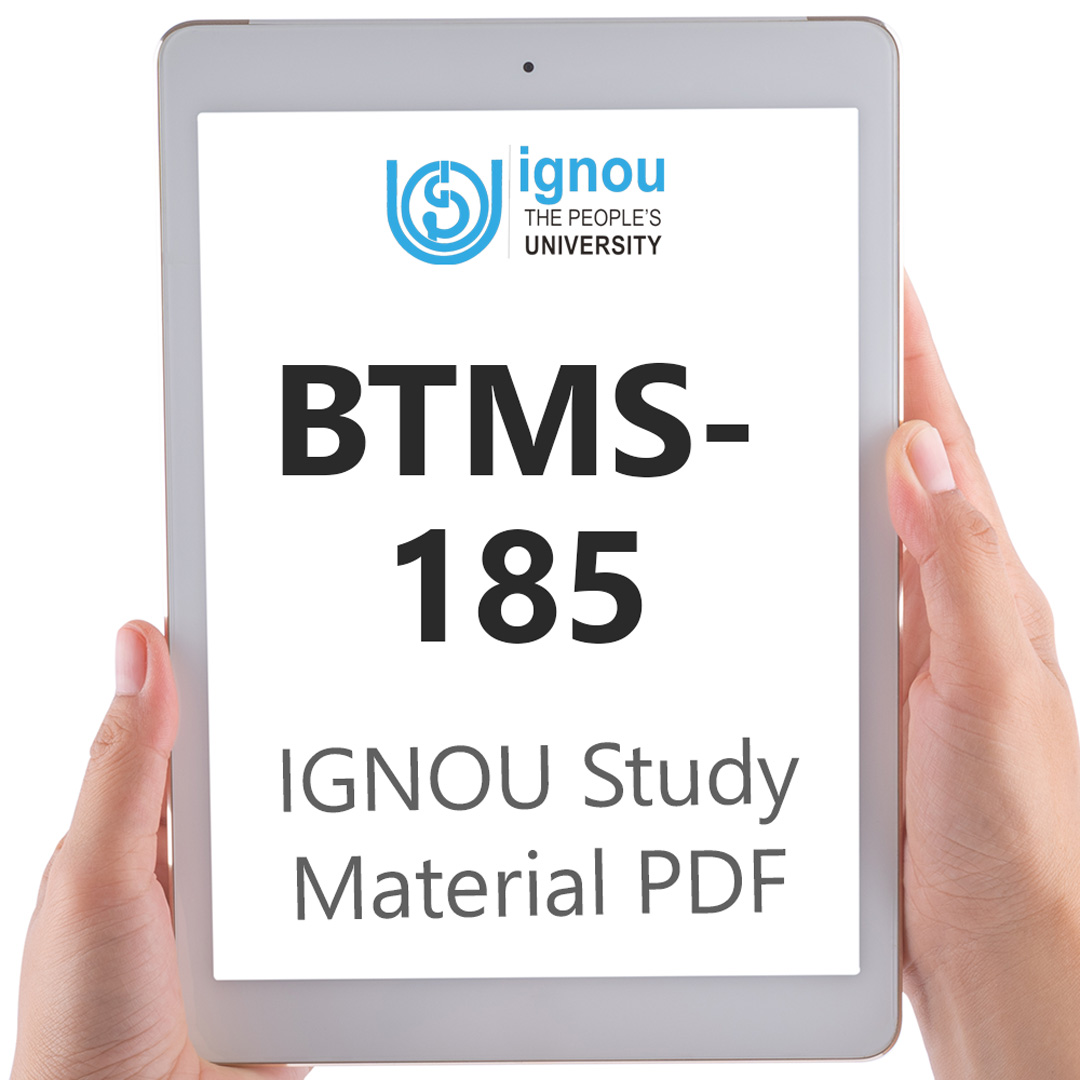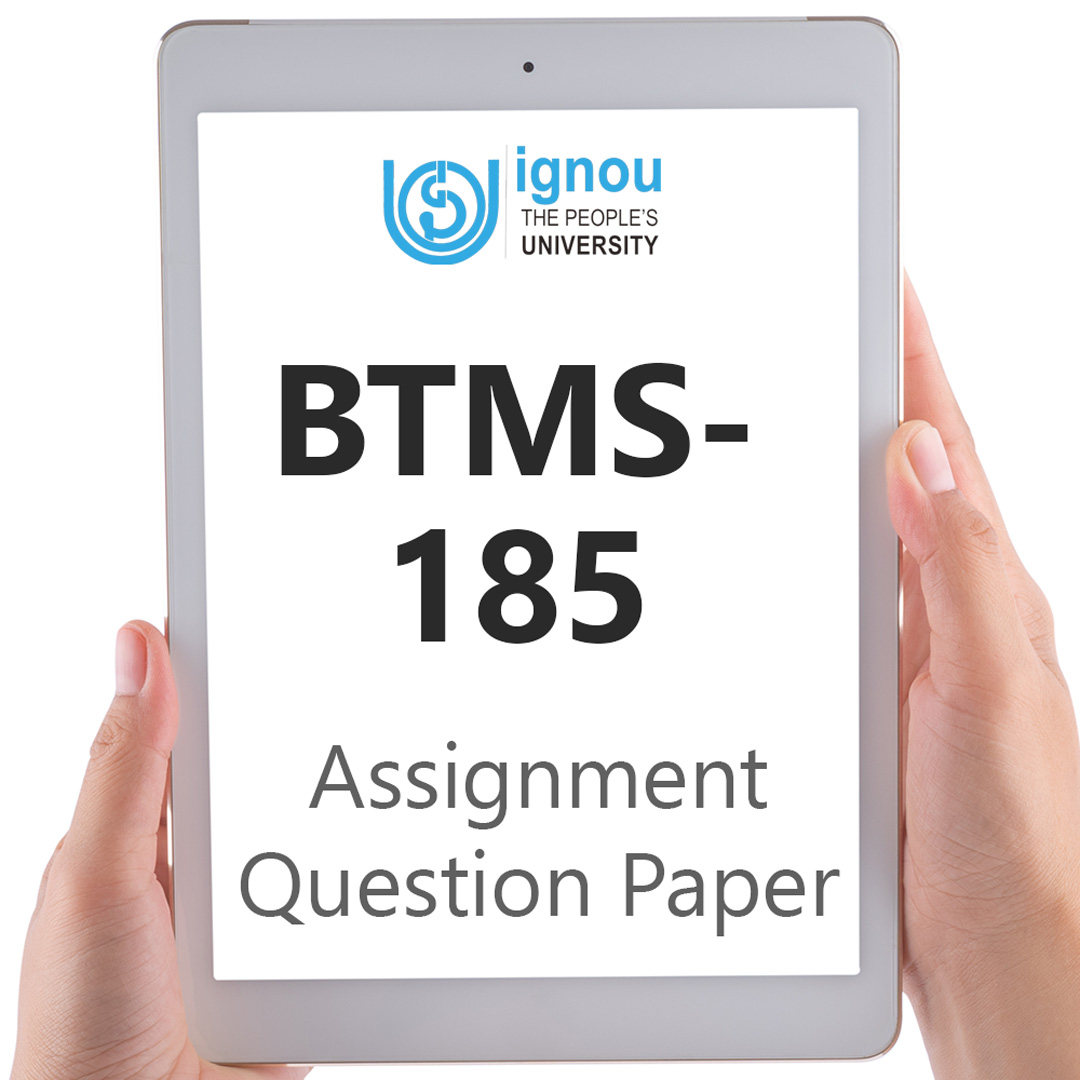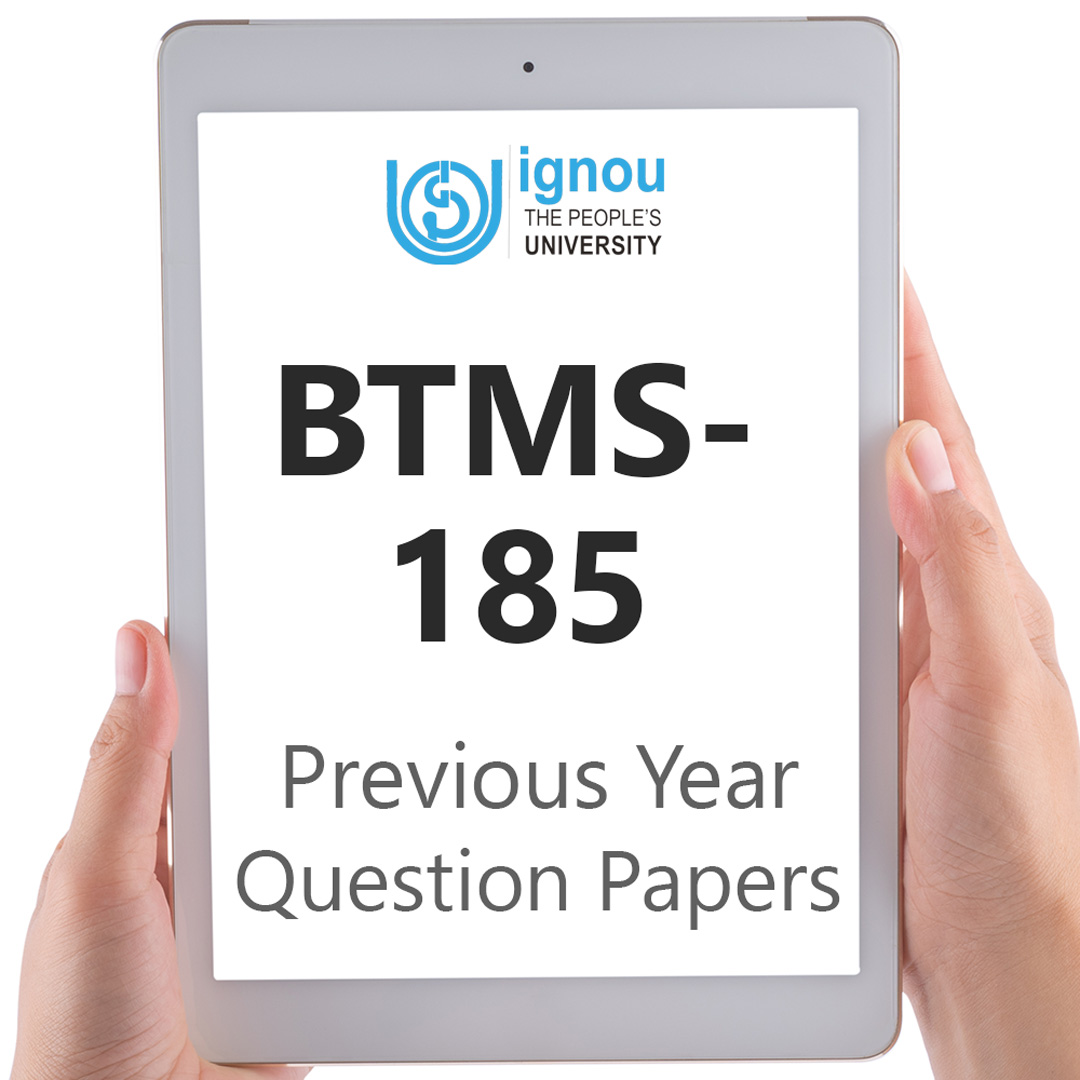If you are looking for BTMS-185 IGNOU Solved Assignment solution for the subject Airport Handling, you have come to the right place. BTMS-185 solution on this page applies to 2023-24 session students studying in BAVTM, BTS, BATS courses of IGNOU.
BTMS-185 Solved Assignment Solution by Gyaniversity
Assignment Code: BTMS-185/TMA/2023-24
Course Code: BTMS-185
Assignment Name: Airport Handling
Year: 2023-2024
Verification Status: Verified by Professor
Section A
Answer the following in about 500 words each.
Q1) What do you understand by Air Cargo? What are the different types of Air Cargo?
Ans) Air Cargo: The movement of products by air uses aircraft that have been specifically designed or adapted for cargo operations. This type of transportation is referred to as air cargo. The delivery of goods can be accomplished in a quick and effective manner through the utilisation of this form of transportation, which is essential for international, long-distance, and expedited logistics. Air cargo is an essential component of international trade since it provides support to a wide range of sectors and makes it easier to transport products that are either time-sensitive or of high value.
Types of Air Cargo:
a) General Cargo: A wide variety of items that do not fall within the category of specialised cargo are included in the category of general cargo. Boxes, crates, or pallets are all possible packaging options for these things, which cover a wide range of different types of commodities.
b) Express and Couriers: The expedited delivery of packages and papers is what is meant by the term "express freight." The delivery of this kind of cargo is a specialty of courier organisations, which ensures that it is delivered on time and with reliability, typically through specialised air cargo networks.
c) Perishables: Perishable cargo includes goods that have a limited shelf life, such as fresh fruits, vegetables, flowers, and seafood. Specialized temperature-controlled containers or aircraft compartments are used to maintain optimal conditions during transit.
d) Live Animals: Live animal cargo involves the transportation of animals, including pets, livestock, and exotic species. Airlines follow strict regulations to ensure the welfare and safety of the animals during the journey.
e) Dangerous Goods (HAZMAT): Dangerous goods include items that pose a risk to health, safety, property, or the environment. These can be chemicals, flammable materials, or hazardous substances. Strict regulations govern their air transportation to mitigate risks.
f) Heavy and Outsized Cargo: Heavy and oversized cargo encompasses large and heavy items that cannot fit into standard aircraft cargo holds. This may include machinery, industrial equipment, or oversized components.
g) Pharmaceuticals and Medical Supplies: The transportation of pharmaceuticals and medical supplies requires precise temperature control and adherence to strict regulations to ensure the integrity and safety of these products during transit.
h) Aerospace Cargo: Aerospace cargo involves transporting components, equipment, and materials related to the aerospace industry. This includes aircraft parts, engines, and other aviation-related goods.
i) Valuables and High-Security Cargo: During shipping, particular handling and security precautions are required for cargo that is both high-value and sensitive to security concerns. Examples of such cargo include precious metals, artwork, and confidential information.
j) E-commerce Cargo: With the growth of e-commerce, air cargo is increasingly used to transport goods purchased online. Quick delivery times are essential for meeting customer expectations in the e-commerce sector.
k) Mail and Postal Cargo: Air cargo is a vital component of the global postal system, transporting mail and parcels between countries. National postal services often rely on air cargo for international deliveries.
l) Textiles and Garments: Textiles and garments are often transported by air to meet tight production schedules and respond quickly to changing fashion trends. Air cargo enables rapid delivery to global markets.
Q2) What is the role and responsibilities of Airline Management in Passenger handling process?
Ans) The management of airlines plays a significant part in the process of passenger handling, which ensures that passengers have a smooth and effective experience from the time they book their flights until they come to land. As part of their duties in passenger handling, airline management is responsible for a variety of phases during the travel route, including the following:
Booking and Reservation:
a) Role: Putting in place efficient booking and reservation systems to make it easier for passengers to select their seats, buy tickets, and manage their reservations.
b) Responsibilities: The supervision of the creation and upkeep of online booking platforms that are friendly to users.
c) Implementing pricing strategies and managing seat inventory.
d) Ensuring compliance with regulatory requirements for ticketing and reservations.
Check-In Process:
a) Role: The procedure of checking in will be streamlined in order to improve passenger convenience and reduce wait times.
b) Responsibilities: Utilizing mobile and online check-in services as available possibilities.
c) Managing airport check-in counters and self-service kiosks.
d) Ensuring compliance with security and immigration procedures.
Baggage Handling:
a) Role: ensuring that baggage services are managed effectively in order to reduce the risk of loss or damage and to improve passenger satisfaction.
b) Responsibilities: Implementing baggage tracking systems for real-time monitoring.
c) Coordinating with ground handling services for secure baggage handling.
d) Addressing and resolving issues related to lost or delayed baggage.
Boarding Process:
a) Role: In order to provide passengers with a streamlined and well-organized experience, the boarding procedure is being streamlined.
b) Responsibilities: Implementing boarding protocols and procedures.
c) Coordinating with ground staff to manage boarding queues.
d) Providing assistance to passengers with special needs during boarding.
In-Flight Services:
a) Role: Overseeing in-flight services to enhance the overall passenger experience.
b) Responsibilities: Ensuring the availability of amenities, meals, and entertainment options.
c) Monitoring the performance of cabin crew and addressing passenger feedback.
d) Managing in-flight emergencies and disruptions.
Customer Service:
a) Role: Providing exceptional customer service throughout the passenger journey.
b) Responsibilities: Establishing customer service protocols and standards.
c) Handling passenger complaints and feedback.
d) Implementing training programs for frontline staff to enhance customer interaction.
Security and Safety:
a) Role: Making certain that passengers are protected from harm and safe throughout their journey.
b) Responsibilities: Collaborating with relevant authorities to implement security measures.
c) Conducting safety audits and assessments.
d) Developing and implementing emergency response plans.
Immigration and Customs Compliance:
a) Role: When it comes to facilitating international travel, ensuring compliance with immigration and customs procedures is essential.
b) Responsibilities: Collaborating with immigration authorities for streamlined processes.
c) Implementing technology solutions for passport control and customs declarations.
d) Training staff on international travel regulations.
Post-Flight Services:
a) Role: Manage post-flight services in order to provide assistance to travellers upon their arrival.
b) Responsibilities: Coordinating baggage claim and ground transportation services.
c) Providing assistance for connecting flights or onward travel.
d) Handling customer inquiries and concerns after arrival.
Continuous Improvement:
a) Role: Through the implementation of initiatives for continuous improvement, passenger handling procedures can be improved overall.
b) Responsibilities: Analysing performance metrics and passenger feedback.
c) Implementing process improvements based on industry best practices.
d) Staying updated on technological advancements and industry trends.
Section B
Answer the following questions in about 250 words each.
Q3) How can we classify airports based on “Access to the Passenger”?
Ans) Airports can be classified based on the level of access they provide to passengers, taking into account various factors that influence the ease of travel. The classifications are as follows:
Public Airports:
a) Description: Public airports are open to the general public and provide access to both domestic and international flights.
b) Access: Open for use by any airline and accessible to any passenger.
Private Airports:
a) Description: Private airports are not open to the general public and often serve specific purposes, such as corporate or military aviation.
b) Access: Restricted, typically requiring permission for use.
International Airports:
a) Description: International airports facilitate the arrival and departure of passengers on international flights.
b) Access: Serve both domestic and international airlines, accommodating passengers traveling to and from other countries.
Domestic Airports:
a) Description: Domestic airports primarily handle flights within the country's borders.
b) Access: Serve domestic airlines, catering to passengers traveling within the country.
Regional Airports:
a) Description: Regional airports serve specific geographical areas, connecting smaller cities and towns.
b) Access: Provide access to regional and sometimes national carriers.
Hub Airports:
a) Description: Hub airports are major centres for connecting flights, facilitating the transfer of passengers between different airlines and destinations.
b) Access: Serve as central points for various airlines, offering extensive connectivity.
Secondary or Reliever Airports:
a) Description: Secondary airports relieve congestion at major airports and provide additional capacity.
b) Access: Handle overflow traffic and provide alternative options for certain regions.
Satellite Airports:
a) Description: Satellite airports are auxiliary facilities associated with a larger primary airport, often serving as overflow terminals or cargo hubs.
b) Access: Connected to a main airport and share resources.
City or Downtown Airports:
a) Description: City or downtown airports are located close to city centres, providing convenient access to urban areas.
b) Access: Designed to reduce travel time for passengers going to and from city centres.
Q4) Discuss the importance of GDS in changing the business of tourism and travel.
Ans) The importance of GDS can be highlighted in several key aspects:
Distribution Efficiency:
GDS platforms streamline the distribution of travel products, making it efficient for travel agents, airlines, hotels, and other service providers to connect and share information in real-time.
Global Reach:
GDS systems provide a global reach, enabling travel businesses to reach a vast audience and distribute their services internationally. This global connectivity enhances market access and customer reach.
Inventory Management:
GDS systems facilitate efficient inventory management for airlines, hotels, car rental agencies, and other travel services. This ensures that available resources are optimally utilized.
Real-Time Updates:
Travel information, including availability, prices, and reservations, is updated in real-time on GDS platforms. This dynamic information sharing enhances the ability of travel agents and consumers to make informed decisions.
Simplified Booking Process:
GDS systems simplify the booking process by consolidating travel-related services into a single platform. Travel agents can access and book flights, accommodations, and other services seamlessly.
Revenue Maximization:
GDS platforms contribute to revenue maximization for travel providers by ensuring efficient distribution, reducing the risk of underutilized inventory, and optimizing pricing strategies.
Competitive Advantage:
Access to GDS platforms provides travel businesses with a competitive advantage. It allows them to stay competitive in a rapidly changing industry by adopting modern technology and staying connected with the latest market trends.
Data Insights:
GDS systems generate valuable data and insights into consumer behaviour, booking patterns, and market trends. This data-driven approach assists travel businesses in making strategic decisions and tailoring their services to meet customer demands.
Integrated Services:
GDS platforms integrate various travel services, creating a one-stop-shop for travel agents and consumers. This integration enhances convenience and efficiency in the booking process.
Industry Standardization:
GDS systems establish industry standards for data exchange, making it easier for different stakeholders to collaborate and ensuring a common platform for conducting transactions.
Q5) What are the different types of Air Fares?
Ans)Airfares vary based on factors such as flexibility, booking class, and restrictions. Various types of airfares cater to different passenger needs.
a) Normal or Full Fare: Full-priced tickets without restrictions, offering flexibility in terms of changes and refunds. Often chosen by business travellers or those with uncertain travel plans.
b) Discounted or Restricted Fare: Offered at a lower price with specific restrictions, such as advance purchase requirements, minimum stay durations, and limited refund or change options. Common for leisure travellers who plan in advance.
c) Round-Trip Fare: Covers a round-trip journey from the departure to the destination and back. Generally, round-trip fares are more economical than purchasing two one-way tickets.
d) One-Way Fare: Allows passengers to book a ticket for a single journey from one location to another without the commitment of a return journey. Useful for those with flexible travel plans.
e) Excursion or Special Fare: Temporary promotional fares offered for a specific period, often with restrictions on travel dates and durations. Designed to attract passengers during specific seasons or events.
f) Red-Eye Fare: Red-eye flights are overnight flights departing late at night and arriving early in the morning. Red-eye fares may offer cost savings due to less desirable departure and arrival times.
g) Group Fare: Offered to a group of passengers traveling together. Group fares often come with discounted rates and specific conditions, such as a minimum number of passengers.
h) Joint Venture or Codeshare Fare: Result from partnerships between airlines where they share certain flights. Passengers can book a flight on one airline but may travel on another airline within the partnership.
i) Inclusive Tour (IT) Fare: A package deal that combines airfare with other travel components like accommodation and transportation. Commonly used by tour operators.
j) Advance Purchase Fare: Offers lower prices for tickets purchased well in advance. Passengers need to plan and commit to their travel dates to avail of these discounts.
k) Last-Minute Fare: Available for passengers booking close to the departure date. While prices can be higher, last-minute fares cater to those with urgent travel needs.
l) Refundable and Non-Refundable Fare: Refundable fares allow passengers to receive a refund if they cancel their plans, usually with a fee. Non-refundable fares do not permit refunds but may offer the option to make changes with a fee.
Section C
Answer the following questions in about 100 words each.
Q6) What do you understand by disembarkation?
Ans) Disembarkation refers to the process of passengers or goods exiting a vehicle or vessel upon reaching their destination. In the context of air travel, disembarkation occurs when passengers leave the aircraft after it has landed and come to a complete stop. It involves the orderly and controlled exit of passengers from the plane, usually through designated exits such as jet bridges or stairs. Disembarkation is a critical phase in the air travel process, ensuring that passengers can safely and efficiently leave the aircraft, proceed to the terminal, and complete their journey.
Q7i) Differentiate between the aerodrome and airport.
Ans)Difference between the aerodrome and airport:
Q7ii) Differentiate between the airside and landside.
Ans)Difference between the airside and landside:
Q7iii) Differentiate between the green and brown field airports.
Ans)Difference between the green and brown field airports:
Q8) What are the different types of (air) journeys?
Ans) The different types of (air) journeys are:
a) One-Way Journey: Involves traveling from one location to another without a return trip.
b) Round-Trip Journey: Includes a departure from one location and a return journey to the original starting point.
c) Multi-City Journey: Encompasses travel to multiple destinations with different stopovers.
d) Direct Flight: Travels from the departure to the destination without intermediate stops.
e) Connecting Flight: Involves a journey with one or more intermediate stops, requiring passengers to change planes.
f) Non-Stop Flight: Flies directly from the departure to the destination without any intermediate landings.
g) Red-Eye Journey: Refers to overnight flights typically departing late at night and arriving early in the morning.
Q9) Discuss the relevance of ICAO in the aviation sector.
Ans) The International Civil Aviation Organization (ICAO) holds immense relevance in the aviation sector as a specialized agency of the United Nations. It establishes global standards and regulations to ensure the safe, secure, and environmentally sustainable development of international civil aviation. ICAO facilitates cooperation among its 193 member states, fostering uniformity in aviation practices, procedures, and regulations. Its initiatives encompass air navigation, safety oversight, environmental protection, and the harmonization of aviation policies. ICAO's efforts contribute significantly to the interoperability of aviation systems worldwide, promoting a cohesive and efficient global air transportation network.
Q10a) Answer the 3 letter Country code of Nepal and Brazil.
Ans) In the case of Nepal, the three-letter country code is NPL, while in the case of Brazil, it is BRA. In accordance with the ISO 3166-1 alpha-3 standard, these codes are included. This standard gives three-letter codes that are used to designate countries and territories. These codes are utilised extensively in a variety of fields, such as international commerce, aviation, internet domain names, and sporting events, with the purpose of identifying and distinguishing countries in a manner that is both distinctive and distinct. One can refer to particular nations in a format that is widely recognised by using the codes, which provide a simple and standardised method of doing so.
Q10b) Answer the City Code of Harare and Tokyo
Ans) When compared to Tokyo, which is the capital of Japan, the city code for Harare, which is the capital of Zimbabwe, is HRE, and the city code for Tokyo is TYO. For the purpose of facilitating effective communication and logistics, city codes, which are frequently utilised in the context of airport and travel industry regulations, provide a means of individually identifying particular cities. These codes, in conjunction with country codes, help to the development of standardised systems that make it easier to carry out operations such as international travel, transit, and other worldwide activities that require accurate city identification.
Q10c) Answer the When local time in Dhaka (DAC) Bangladesh is 1800hrs on 15th August, what is the local time and date in Honolulu (HNL), Hawaiian Islands, USA?
Ans)Regarding the passage of time, Dhaka, Bangladesh (DAC) is in front of Honolulu, Hawaiian Islands, United States of America (HNL). The time zone that Dhaka is located in is UTC+6, while the time zone that Honolulu is in is UTC-10. The difference in time is sixteen hours over. It follows that if it is 1800 hours (6:00 PM) on the 15th of August in Dhaka, then it would be 0200 hours (2:00 AM) on the same day in Honolulu. There is no difference in the date between the two sites. Dhaka is ahead of Honolulu in terms of time, and the time difference is a factor that contributes to this variation.








